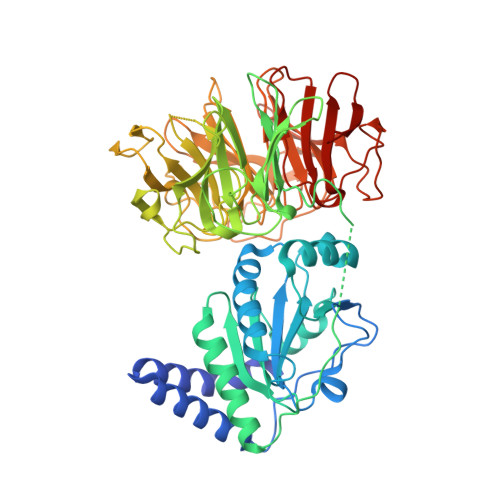Structural analysis of human NHLRC2, mutations of which are associated with FINCA disease.
Biterova, E., Ignatyev, A., Uusimaa, J., Hinttala, R., Ruddock, L.W.(2018) PLoS One 13: e0202391-e0202391
- PubMed: 30138417
- DOI: https://doi.org/10.1371/journal.pone.0202391
- Primary Citation of Related Structures:
6G7W, 6GC1 - PubMed Abstract:
NHLRC2 (NHL repeat-containing protein 2) is an essential protein. Mutations of NHLRC2, including Asp148Tyr, have been recently associated with a novel FINCA disease (fibrosis, neurodegeneration, cerebral angiomatosis), which is fatal in early childhood. To gain insight into the mechanisms of action of this essential protein, we determined the crystal structure of the Trx-like and NHL repeat β-propeller domains of human NHLRC2 to a resolution of 2.7 Å. The structure reveals two domains adjacent to each other that form a cleft containing a conserved CCINC motif. A SAXS structure of full-length NHLRC2 reveals that the non-conserved C-terminal domain does not pack against the N-terminal domains. Analysis of the surface properties of the protein identifies an extended negative electrostatic potential in the surface of the cleft formed by the two domains, which likely forms a binding site for a ligand or interaction partner(s). Bioinformatics analysis discovers homologs across a range of eukaryotic and prokaryotic species and conserved residues map mostly to the adjacent surfaces of the Trx-like and β-propeller domains that form the cleft, suggesting both that this forms the potential functional site of NHLRC2 and that the function is conserved across species. Asp148 is located in the Trx-like domain and is not conserved across species. The Asp148Tyr mutation destabilizes the structure of the protein by 2°C. The NHLRC2 structure, the first of any of its homologs, provides an important step towards more focused structure-function studies of this essential protein.
- Faculty of Biochemistry and Molecular Medicine, University of Oulu, Oulu, Finland.
Organizational Affiliation:
















